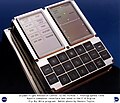Файл:Apollo display and keyboard unit (DSKY) used on F-8 DFBW DVIDS683588.jpg

Размер этого предпросмотра: 765 × 600 пкс. Другие разрешения: 306 × 240 пкс | 612 × 480 пкс | 980 × 768 пкс | 1280 × 1004 пкс | 2560 × 2007 пкс | 3030 × 2376 пкс.
Исходный файл (3030 × 2376 пкс, размер файла: 6,18 Мб, MIME-тип: image/jpeg)
История файла
Нажмите на дату/время, чтобы посмотреть файл, который был загружен в тот момент.
| Дата/время | Миниатюра | Размеры | Участник | Примечание | |
|---|---|---|---|---|---|
| текущий | 06:29, 9 октября 2021 |  | 3030 × 2376 (6,18 Мб) | Huntster | Cropped 9 % vertically using CropTool with lossless mode. |
| 06:28, 9 октября 2021 |  | 3030 × 2606 (5,97 Мб) | Huntster | Full resolution from NASA. | |
| 00:42, 6 мая 2015 |  | 1536 × 1321 (303 Кб) | Fæ | == {{int:filedesc}} == {{milim | description = {{en|1=The display and keyboard (DSKY) unit used on the F-8 Digital Fly-By-Wire (DFBW) aircraft during Phase I of the fly-by-wire program. Warning lights are in the upper left section, displays in the uppe... |
Использование файла
Следующая страница использует этот файл:
Глобальное использование файла
Данный файл используется в следующих вики:
- Использование в ar.wikipedia.org
- Использование в en.wikipedia.org
- Использование в es.wikipedia.org
- Использование в fi.wikipedia.org
- Использование в fr.wikipedia.org
- Использование в he.wikipedia.org
- Использование в hu.wikipedia.org
- Использование в ja.wikipedia.org
- Использование в pl.wikipedia.org
- Использование в uk.wikipedia.org

